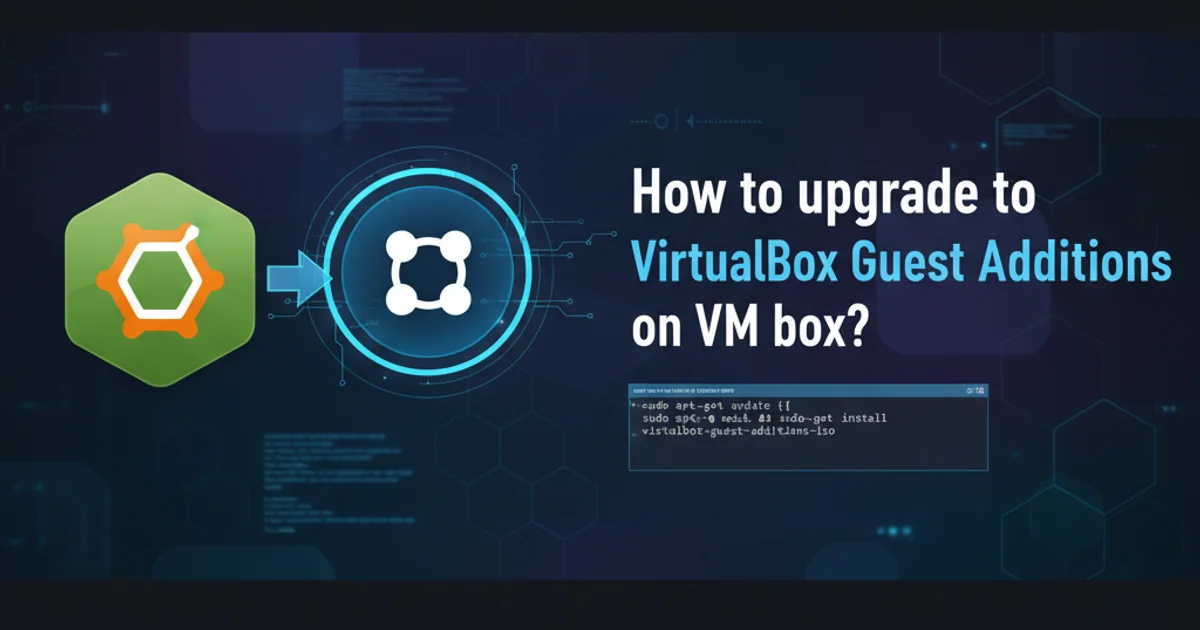How to upgrade to VirtualBox Guest Additions on VM box?
Categories:
Seamless Integration: Upgrading VirtualBox Guest Additions on Ubuntu VMs

Learn how to upgrade VirtualBox Guest Additions on your Ubuntu-based Vagrant VMs for enhanced performance, shared folders, and seamless mouse integration.
VirtualBox Guest Additions are a collection of device drivers and system applications designed to improve the performance and usability of guest operating systems running in VirtualBox. For Ubuntu-based Vagrant virtual machines, keeping these additions up-to-date is crucial for features like shared folders, clipboard integration, and better display resolution. This guide will walk you through the process of upgrading Guest Additions, addressing common pitfalls, and ensuring a smooth experience.
Why Upgrade Guest Additions?
Outdated Guest Additions can lead to various issues, including slow graphics performance, lack of shared folder functionality, and problems with mouse pointer integration. Upgrading ensures your VM can fully leverage VirtualBox's capabilities, providing a more native and efficient user experience. This is especially important in development environments where shared folders are frequently used for code synchronization between the host and guest.
flowchart TD
A[Start VM] --> B{Guest Additions Outdated?}
B -- Yes --> C[Update System Packages]
C --> D[Install Build Essentials]
D --> E[Mount Guest Additions ISO]
E --> F[Run Installer Script]
F --> G[Reboot VM]
G --> H[Verify Installation]
B -- No --> H
H[End]Workflow for upgrading VirtualBox Guest Additions
Prerequisites and Initial Setup
Before attempting to upgrade Guest Additions, ensure your VM is in a clean state and has the necessary tools. This typically involves updating your system's package list and installing development tools required to compile kernel modules. For Vagrant users, this means SSHing into your VM.
vagrant ssh
sudo apt update
sudo apt upgrade -y
sudo apt install -y build-essential linux-headers-$(uname -r)
Commands to SSH into your Vagrant VM, update packages, and install build tools.
Mounting and Installing Guest Additions
Once the prerequisites are met, the next step is to mount the VirtualBox Guest Additions ISO and run the installer script. VirtualBox typically provides an option in the 'Devices' menu to 'Insert Guest Additions CD image...'. If you're working with a headless Vagrant VM, you'll need to manually download and mount the ISO or use a method that simulates this action.
1. Insert Guest Additions CD Image
From the VirtualBox menu, navigate to Devices -> Insert Guest Additions CD image.... This will virtually attach the ISO to your VM. If you're using a headless VM, you might need to manually download the ISO and mount it, or Vagrant might handle this automatically during vagrant up if configured correctly.
2. Create Mount Point and Mount ISO
Inside your VM, create a directory to mount the ISO and then mount it. The device name for the CD-ROM might vary, but /dev/cdrom is common.
3. Run the Installer Script
Navigate to the mounted directory and execute the installer script. The sudo command is essential as this installation modifies system files and kernel modules.
4. Reboot the Virtual Machine
After the installation completes, it's crucial to reboot your VM for the changes to take effect. This ensures that the new kernel modules are loaded and services are restarted.
5. Verify Installation
After rebooting, you can verify the installation by checking the VirtualBox kernel modules or testing features like shared folders and clipboard integration.
sudo mkdir -p /mnt/cdrom
sudo mount /dev/cdrom /mnt/cdrom
cd /mnt/cdrom
sudo ./VBoxLinuxAdditions.run
# After installation, reboot:
sudo reboot
# To verify (after reboot):
lsmod | grep vboxguest
Commands for mounting the ISO, running the installer, rebooting, and verifying.
build-essential and the correct linux-headers package for your running kernel are installed. Mismatched kernel headers are a common cause of installation failures.Troubleshooting Common Issues
Sometimes, the upgrade process might not go as smoothly as planned. Here are a few common issues and their solutions:
- "Unable to insert the virtual optical disk...": This usually means the Guest Additions ISO is already mounted or there's an issue with the VirtualBox installation itself. Try unmounting any existing CD-ROMs or restarting VirtualBox.
- Kernel module compilation errors: Ensure
build-essentialandlinux-headers-$(uname -r)are installed and up-to-date. Sometimes, a kernel update requires a reboot before new headers are recognized. - Shared folders not working: After a successful Guest Additions installation, ensure your user is part of the
vboxsfgroup. You might need to add your user and then log out/in or reboot.
# Add current user to vboxsf group
sudo usermod -aG vboxsf $USER
# Then log out and back in, or reboot.
Adding your user to the vboxsf group for shared folder access.